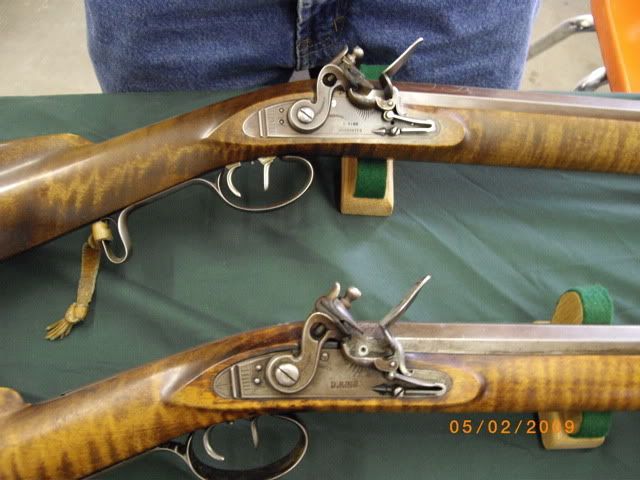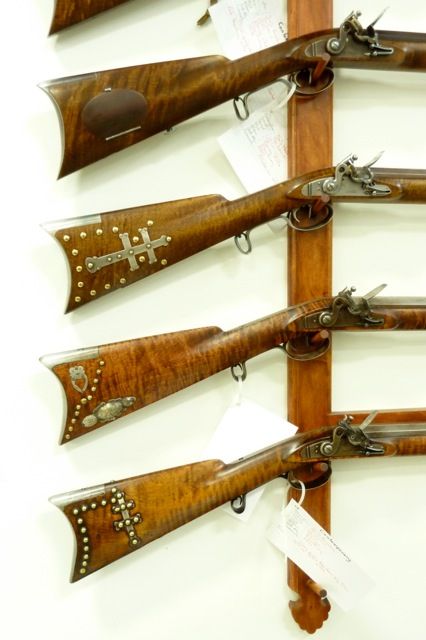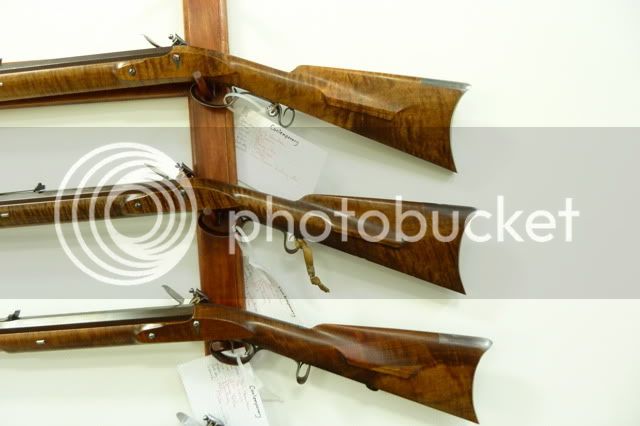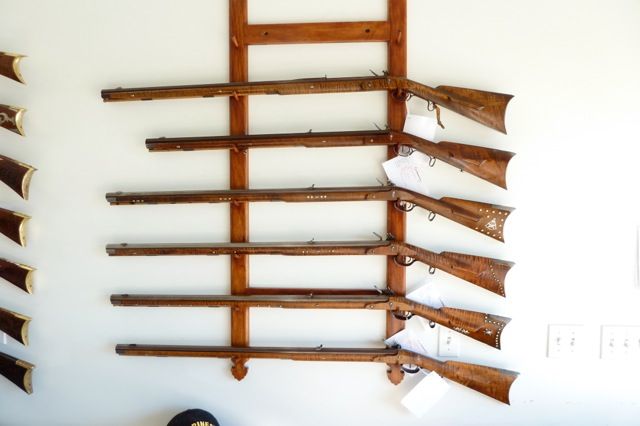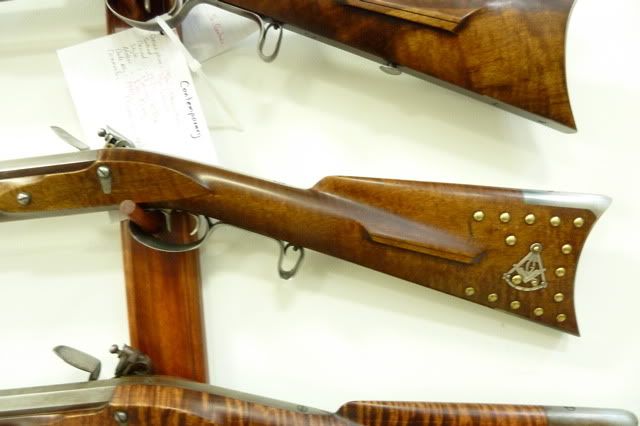I was surprised to see escutcheons around the keys used on the Sapergia version. I had been advised by several sources that escutcheons were not used on very early "plains style" Hawken fullstock rifles. :idunno:
You are using an out of date browser. It may not display this or other websites correctly.
You should upgrade or use an alternative browser.
You should upgrade or use an alternative browser.
full stock Hawken flintlock
- Thread starter Khufu
- Start date

Help Support Muzzleloading Forum:
This site may earn a commission from merchant affiliate
links, including eBay, Amazon, and others.
Thanks for the good information- yes that was the "flintlock" I was thinking about. On a snail type set up- would the cut in the lock plate be larger? In other words- what I thought might be a flint to which a plain drum was put in- what about a patent breech "snail" that somehow got damaged so the barrel was removed and cut shorter and then a plain drum put in as a repair- would that leave a larger area cut out on the lock plate? Hope I explained it correctly.
I didn't know that many full stocks were made.
On the wedge without plates. I've seen some "Kentucky" rifles with wedges- no plates. I assumed there was no hooked breech, wedges were simply used instead of pins. In any event when I see just wedges without plates I sort of figure the barrel was meant to stay in place- no hooked breech.
I didn't know that many full stocks were made.
On the wedge without plates. I've seen some "Kentucky" rifles with wedges- no plates. I assumed there was no hooked breech, wedges were simply used instead of pins. In any event when I see just wedges without plates I sort of figure the barrel was meant to stay in place- no hooked breech.
hoochiepapa
75 Cal.
- Joined
- Oct 25, 2010
- Messages
- 5,853
- Reaction score
- 7
I know you're after "Hawkens", but in the July/Aug. issue of Muzzleloader there is an interesting account of the fur trade and the gun maker's involved. Long barrels, .58 caliber, and full stock.
Khufu
40 Cal.
I am after a Hawken only because the stock geometry fits me so well, and I am trying to be accurate because it is such an Icon in the history of the American rifle. I am not looking for a rifle that fits a particular period, just one that I can use to hunt big game, from a horse.
I could just make something up, and it would work just as well, but I do not have a Hawken replica so two birds one stone. I have a p53 Enfield, it would work, but its not a flintlock. rather than copy a particular style and distort is geometry to fit me, which I have done, I would rather pick something to copy that fits. at the city range here in albuquerque most muzzleloaders are inlines, the rest mass produced or badly assembled kit guns. not anything to ask if you could take a shot with. I attended a few Rendezvous when I lived in Utah, But I was too young and stupid to pay attention. I simply picked a Hawken because I know they fit.
I could just make something up, and it would work just as well, but I do not have a Hawken replica so two birds one stone. I have a p53 Enfield, it would work, but its not a flintlock. rather than copy a particular style and distort is geometry to fit me, which I have done, I would rather pick something to copy that fits. at the city range here in albuquerque most muzzleloaders are inlines, the rest mass produced or badly assembled kit guns. not anything to ask if you could take a shot with. I attended a few Rendezvous when I lived in Utah, But I was too young and stupid to pay attention. I simply picked a Hawken because I know they fit.
galamb
58 Cal.
Here is a couple more pictures of the lock area.
I just do not believe that Sam, who was a great builder, would do such a "hatchet job" on the lockplate.
I DOES look to be cut for a snail, not a drum. And again, nobody knows when what was done to this rifle or what it looked like when Sam got done with it in the first place.


I just do not believe that Sam, who was a great builder, would do such a "hatchet job" on the lockplate.
I DOES look to be cut for a snail, not a drum. And again, nobody knows when what was done to this rifle or what it looked like when Sam got done with it in the first place.


Doug Lykins
40 Cal.
- Joined
- Dec 28, 2008
- Messages
- 303
- Reaction score
- 1
"I am not looking for a rifle that fits a particular period, just one that I can use to hunt big game, from a horse."
I think elk hunting from horseback is where a Hawken really shines. With the long tang and trigger plate the Hawken is a very durable gun, much less susceptible to breaking at the grip area. If you need to clean it while on the hunt the hook breech is a great advantage.
I'd like to put a rifle together in .54 with a Chambers Ketland flint, about a 33" barrel, using a half-stock. :hmm:
I think elk hunting from horseback is where a Hawken really shines. With the long tang and trigger plate the Hawken is a very durable gun, much less susceptible to breaking at the grip area. If you need to clean it while on the hunt the hook breech is a great advantage.
I'd like to put a rifle together in .54 with a Chambers Ketland flint, about a 33" barrel, using a half-stock. :hmm:
Going with a southren style rifle in full stock and flintlock you get very close to the same fit as with a hawken. Lancaster 'plain rifles' like the JJ Henry and the 1803 US rifle the harpers ferry rifle alsofit simular to a hawken.Khufu said:I am after a Hawken only because the stock geometry fits me so well, and I am trying to be accurate because it is such an Icon in the history of the American rifle. I am not looking for a rifle that fits a particular period, just one that I can use to hunt big game, from a horse.
I could just make something up, and it would work just as well, but I do not have a Hawken replica so two birds one stone. I have a p53 Enfield, it would work, but its not a flintlock. rather than copy a particular style and distort is geometry to fit me, which I have done, I would rather pick something to copy that fits. at the city range here in albuquerque most muzzleloaders are inlines, the rest mass produced or badly assembled kit guns. not anything to ask if you could take a shot with. I attended a few Rendezvous when I lived in Utah, But I was too young and stupid to pay attention. I simply picked a Hawken because I know they fit.
It will be your gun, and there is nothing wrong with having a gun pattrened on full stock hawken in a flint. 175 years ago if you had requsted them to build and you had $25 they would have said words to the effect of Yes sir, it will be ready in 60 days, thank you for your bussiness'
If what you want is an 'in the style of' there is nothing wrong with that, and few are the events you could go to that would bat an eye at a flint hawken plains rifle. If you want somthing that is close to a hawken plains rifle in flint you have options that are historicly correct.
Khufu
40 Cal.
I am looking at a L&R late English lock 36" tapered Rice barrel 1 1/8"to 1" in .58cal 1 in 70 twist round bottom cut rifling iron furniure and copy that possible flint gun's stock. if I were to guess (read wishful thinking)the original lock, a flinter was damaged, and some small town "black smith" drilled the touch hole and added the drum, then salvaged a percussion lock for a snail drum from a blown up rifle and hacked it to fit the drum. as has been noted Sam Hawken was too good to do a hack job like that. I have a friend in DC and I will ask her nicely to go to the smithsonian and photograph the heck out of that rifle and ask a curator a dimention so the rest can be done on a computer. there has been some awesome information posted here, and some of those beautiful Hawkens have really got me commited to building this gun.myshootinstinks said:I think elk hunting from horseback is where a Hawken really shines. With the long tang and trigger plate the Hawken is a very durable gun, much less susceptible to breaking at the grip area. If you need to clean it while on the hunt the hook breech is a great advantage.
I'd like to put a rifle together in .54 with a Chambers Ketland flint, about a 33" barrel, using a half-stock. :hmm:
I will contact Don Stith and pick his brain he has stated he has seen a flint gun, and god be willing, he may have pics, or at least be able to say if the smithsonian gun looks like the flinters he has seen. as far as the hooked breach I will stay with a fixed breech, I have a pin punch in my Lancaster's patchbox and a turn screw in my hunting bag, and can pull the barrel and lock real quick in the field for cleaning. but that 42" barrel is too long for horse back.
Khufu
40 Cal.
I have fired a TOTW southern mountain kit gun, the builder was a novice and it was serviceable, but not fit trigger to lock very well and the geometry was a little off. the stock was just not comfortable I had to crook my neck to get on the sights and it had a single trigger, and I am used to a set. I have never shouldered a Harpers ferry, I would surely like to. but the more of these Hawken pics I see, the more I think I could actually cheat on my Lancaster. The Hawken is a real pretty lady.
I realize we have sort of two dialogues but on that "flintlock" Hawken. Thanks for the close up photo- I never saw the detail before. It doesn't look like it could have been a flintlock in which the frizzen spring was removed, etc. There is also a bad gap between barrel and breech plug. I suppose it is anyone's guess but I wonder if someone had an original Hawken where the cone breech area got corroded or damaged so it was replaced by a someone other than Hawken and they put in a plain drum.
I think that photo is the only thing ever used to argue there were Hawken plains/mountain type rifles with a flintlock.
And...back on topic. There were other makers of heavy plains rifles, I think most were percussion but were there any flintlocks?
I think that photo is the only thing ever used to argue there were Hawken plains/mountain type rifles with a flintlock.
And...back on topic. There were other makers of heavy plains rifles, I think most were percussion but were there any flintlocks?
Back then no one knew they were making a plains rifle or a southern rifle or Ohio rifle or what ever. The fur companies and the us governments Indian factories, had ordered plain large caliber rifles flint rifles. Styles changed and arbitrarily we called a gun a plains rifle. Percussion was the go to by the time that what we call plains rifles were designed. Before that large short barreled full stock flint locks guns were sent west. A rose by any other name.
Khufu
40 Cal.
I spoke to Don Stith today and he has some interesting insights. he does not beleive the smithsonian gun was a flint he did handle 2 guns that were flint, which were later destroyed in a fire. he said he cleaned up the iron parts remaining and the tenions were dovetailed, not staked, which made him question their authenticity. the only example he believes to be authentic is in the Montana historical society museum. the lock is a converted flint, it has a drum and has a triggergard thats a cross between a fowler and a Hawken. He is planning to make a pattern of its stock which has a beavertail cheakpiece not classic hawken, rather than shaping my own, I am gonna get first in line for one.
Khufu
40 Cal.
These are some of the pictures Don Stith sent me of the Hawken he is going to duplicate the stock from, bigfoot does exist.
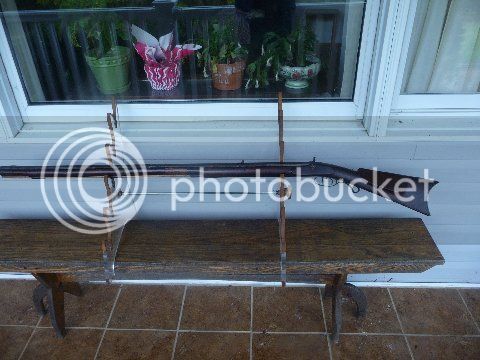
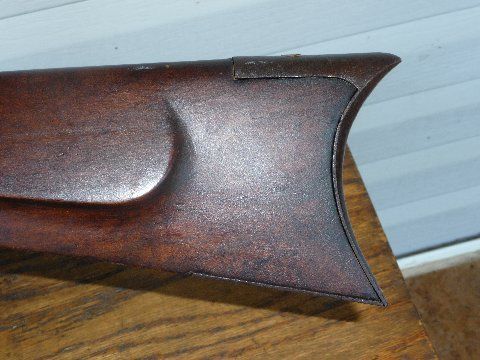

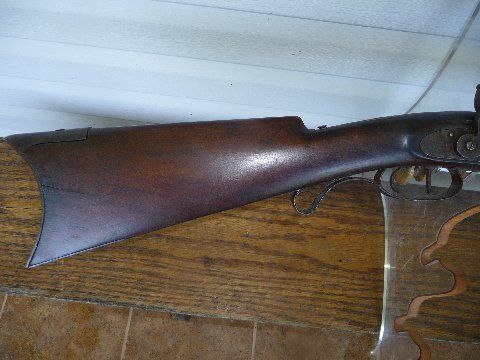
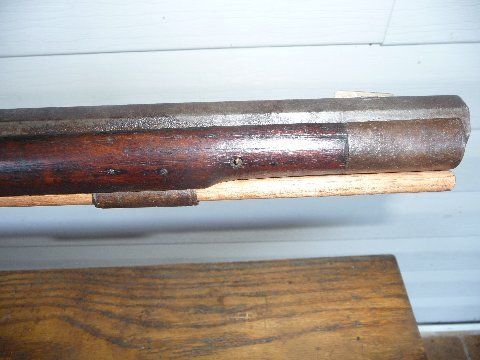
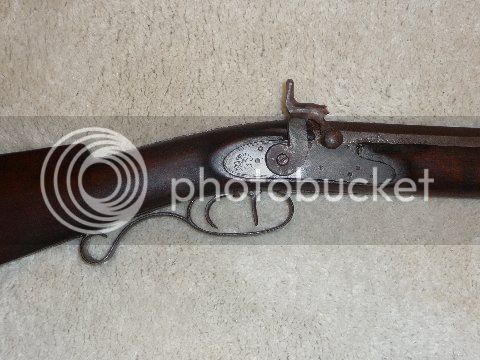
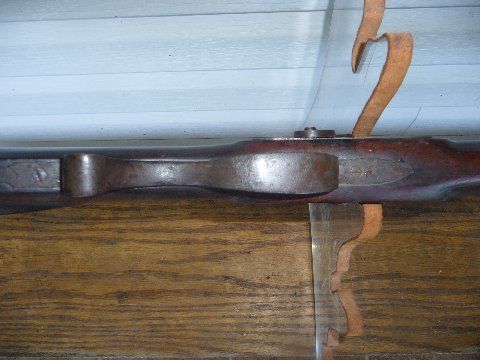









Its entirely possible the heavy rifle marked S Hawken may have been converted to percussion by the Hawken Shop and maybe freshed and marked at that time. The stamp is the only thing that looks like a Hawken product and nothing at all like the S Hawken rifles.
Dan
Dan
Given the detailed photos I have seen of the Smithsonian rifle with the lock removed I cannot conclude its anything but a hooked breech FL rifle that was converted to percussion by fitting a drum into the vent and sawing/filing the water proof pan and frizzen mount from the plate leaving the free standing fence on the plate. John Baird did a photo spread on this rifle with the lock removed in "The Buckskin Report", Dec 1977 page 9, back in the 1970s. It plainly was flint originally. No matter what Col. Goodwin wrote.
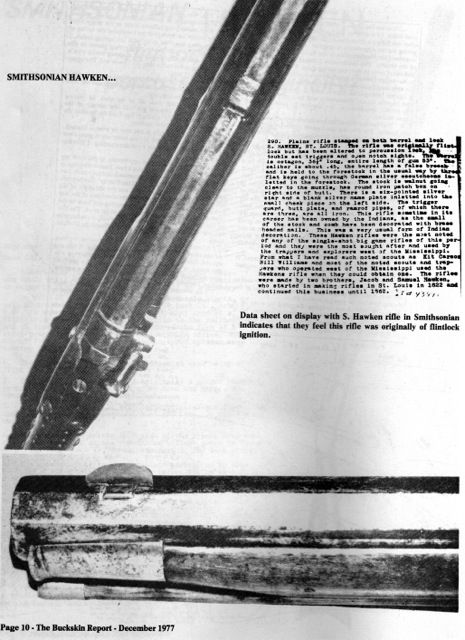

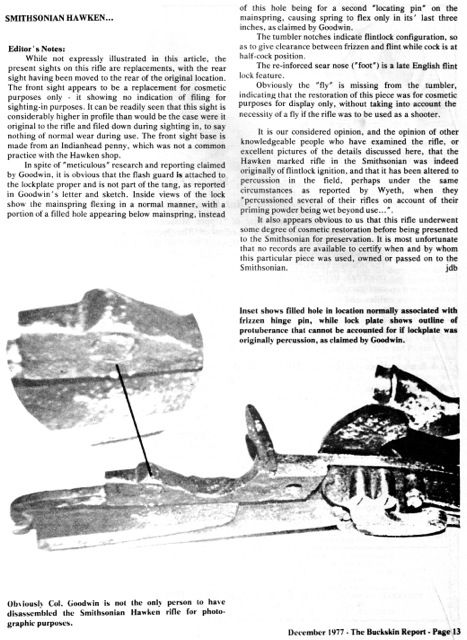



stuart cee dub
32 Cal.
- Joined
- May 14, 2011
- Messages
- 8
- Reaction score
- 1
Thanks Dan for posting the article regarding the Smithsonian Hawken .I found this quite convincing especially the photos of the inside of the lock showing the lock started off life as a flintlock .
Some cars never make it back to the dealer for repairs .Same is true for guns .
Regards,
Stuart
Some cars never make it back to the dealer for repairs .Same is true for guns .
Regards,
Stuart
galamb
58 Cal.
There is no doubt that the lock plate in particular started life as a flint lock - no argument there.
The question has always been "when was it converted?" - before or after it was installed on that rifle IS what is important.
If you BELIEVE that there was a Flint Plains Hawken then you saw "after".
If you DOUBT then you say it was reworked "before" Sam stuck it on that rifle, if he put that lock on at all (maybe the "original percussion lock" got damaged and that was fashioned to fit by someone else - it sure doesn't look up to the quality of Sam's work).
Without the Video Tape from the shop when that rifle was put together, the debate will go on.
The question has always been "when was it converted?" - before or after it was installed on that rifle IS what is important.
If you BELIEVE that there was a Flint Plains Hawken then you saw "after".
If you DOUBT then you say it was reworked "before" Sam stuck it on that rifle, if he put that lock on at all (maybe the "original percussion lock" got damaged and that was fashioned to fit by someone else - it sure doesn't look up to the quality of Sam's work).
Without the Video Tape from the shop when that rifle was put together, the debate will go on.
Similar threads
- Replies
- 25
- Views
- 2K
- Replies
- 54
- Views
- 5K
- Replies
- 1
- Views
- 514
SOLD - Pending funds
Custom Full Stock Hawken Rifle In .50
- Replies
- 4
- Views
- 773




